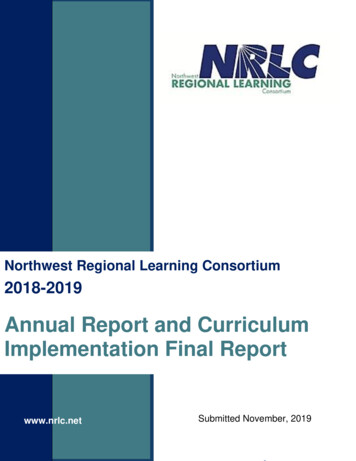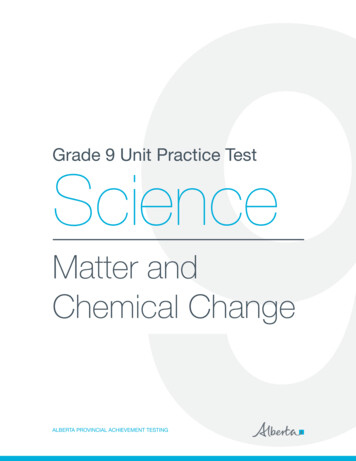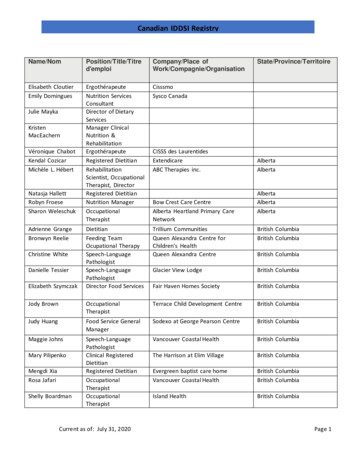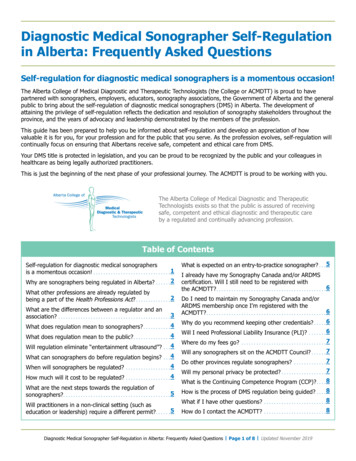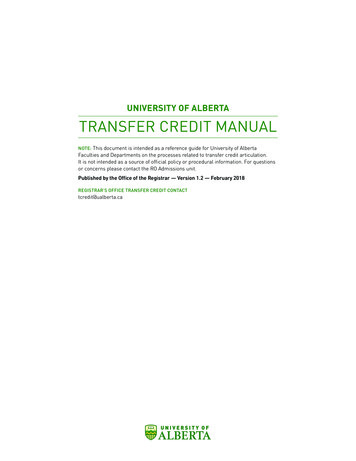
Transcription
UNIVERSITY OF ALBERTATRANSFER CREDIT MANUALNOTE: This document is intended as a reference guide for University of AlbertaFaculties and Departments on the processes related to transfer credit articulation.It is not intended as a source of official policy or procedural information. For questionsor concerns please contact the RO Admissions unit.Published by the Office of the Registrar — Version 1.2 — February 2018REGISTRAR’S OFFICE TRANSFER CREDIT CONTACTtcredit@ualberta.ca
UNIVERSITY OF ALBERTATRANSFER CREDIT MANUALTABLE OF CONTENTS1 1.0 INTRODUCTION1 1.1 Document Purpose1 1.2 Transfer and Transfer Credit Basics1 1.2.1 Quick Definitions1 1.2.2 Transfer Credit Articulation Procedure (UAPPOL)1 1.2.3 Academic Standards Committee (ASC)2 1.3 Office of the Registrar Admissions unit2 2.0 TRANSFER ALBERTA AND THE ALBERTA COUNCIL ON ADMISSIONS AND TRANSFER (ACAT)2 2.1 Alberta Council on Admissions and Transfer (ACAT)2 2.1.1 ACAT Member Institutions3 2.2 ACAT Articulation Committees3 2.3 Transfer Alberta - Online Transfer Guide (ATG)4 3.0 ACAT TRANSFER CREDIT PROPOSAL REVIEW PROCESS4 3.1 Process Overview4 3.2 Department Review and Recommendation Processes (Step 2 from Overview)4 3.2.1 Department Review of Transfer Credit Proposal6 3.2.2 Department Recommendation to Faculty of Transfer Credit7 3.3 Faculty Review and Recommendation Processes (Steps 3 & 4 from Overview)7 3.4 Proposal Review, Recommendation, and Approval Timelines7 3.5 ACAT ATG and Campus Solutions Updating (Step 5 from Overview)8 4.0 BLOCK TRANSFER CREDIT - ACAT8 4.1 Block Transfer Credit Articulation Process8 5.0 NON-ACAT TRANSFER ASSESSMENT PRACTICES AT THE TIME OF ADMISSION8 5.1 RO Processes9 5.2 Faculty/Department Processes9 5.3 Approved Study Abroad Programs9 6.0 HOW TO FIND APPROVED TRANSFER AGREEMENTSAPPENDICES10 Sample Transfer Credit Proposal Summary Form11 Sample Cover Email For Electronic Transfer Credit Proposal12 Essential Course Outline Details13 Guide to using ROADM COURSE TRANSFER RULES Public Query16 Letter of Agreement20 ACAT Electronic Proposal Process
PAGE 11.0 INTRODUCTION1.1 DOCUMENT PURPOSEThis document is intended as a tool for internal University of Alberta Departmentand Faculty staff who review transfer proposals from Alberta postsecondaryinstitutions received from the Registrar’s Office in support of the Alberta Council onAdmission and Transfer (ACAT) review procedure. This manual also serves to provideother resources to assist with transfer assessment practices.1.2 TRANSFER AND TRANSFER CREDIT BASICS1.2.1 QUICK DEFINITIONS Transfer is the movement of students between postsecondary institutions.[definition: Alberta Transfer Guide ] Transfer credit is the credit awarded for prior postsecondary studies if the transfercourse grade is a minimum of C- (or equivalent). This rule applies to all transfer credit. Course transfer credit is credit awarded on a course-by-course basis. Block transfer credit is a “block” of credit awarded on the basis of a completedcredential (e.g. certificate, diploma), or a block of specified courses transferred asa block of knowledge,1.2.2 TRANSFER CREDIT ARTICULATION PROCEDURE (UAPPOL) Transfer Credit Articulation Procedure document pertaining to ACAT transfer Purpose of the document is to facilitate the transfer credit review processbetween the University of Alberta and other Alberta post secondary institutions,within the UofA endorsed principles set out by ACAT.1.2.3 ACADEMIC STANDARDS COMMITTEE (ASC)Transfer Credit ArticulationProcedure is contained in theUofA Policies and ProceduresOnline found at: re.pdf Standards committee of the University of Alberta General Faculties Council (GFC) Endorses Faculty decisions on transfer proposals –report submitted byRegistrar’s Office monthly Terms of Reference iesCouncil.aspx Chaired by the Vice Provost Academic, membership is predominately AssociateDeans (Undergraduate Programs) from all faculties1.3 OFFICE OF THE REGISTRAR ADMISSIONS UNIT (ADM) Receives initial proposal from sending institution and communicates as necessaryto prepare proposal and materials Submits proposal and materials to department/Faculty for assessment Responds to department and Faculty questions during review deliberationsand requests for additional information from sending institution as required Receives completed proposals with transfer credit decisions from Faculty Prepares and submits report to ASC (approvals for final endorsement,denials for information) Following ASC endorsement communicates decision to sending institutionsthrough ACAT database Updates Campus solutions with new agreements or changes to agreements Responds to sending institutions’ changes to existing agreementsUNIVERSITY OF ALBERTA TRANSFER CREDIT MANUAL VERSION 1.2
PAGE 22.0 TRANSFER ALBERTA AND THE ALBERTACOUNCIL ON ADMISSIONS AND TRANSFER (ACAT)2.1 ALBERTA COUNCIL ON ADMISSION AND TRANSFER (ACAT) Established in 1974 Falls under Government of Alberta – Alberta Enterprise and Advanced Education Serves as an advisory body through which stakeholders work co-operatively forthe benefit of learners to ensure smooth transitions and effective transferabilityof courses and programs within the postsecondary system. Involved in facilitation and monitoring of policy on transfer within the province Maintains the database of negotiated and approved transfer agreementsbetween institutions Prepares and maintains the online Alberta Transfer Guide. (Effective 2010-11 nolonger publishes a transfer agreements in an annual paper edition of the Guide.)2.1.1 ACAT MEMBER INSTITUTIONSAlberta College - EdmontonNAITAlberta College of Art DesignNazarene University College(now under Ambrose University College)Alliance University College(now under Ambrose University College)Nechi Training, Research and Health Promotions InstituteAmbrose University CollegeNorQuest CollegeAthabasca UniversityNorthern Lakes CollegeAugustana University CollegeNunavut Arctic CollegeAurora CollegeOld Sun Community CollegeBanff Centre, TheOlds CollegeBlue Quills First Nations CollegePortage CollegeBow Valley CollegePrairie Bible CollegeCanadian University CollegeRed Crow Community CollegeColumbia College - CalgaryRed Deer CollegeConcordia University College of AlbertaRocky Mountain CollegeDeVry Institute of Technology - CalgaryRoyal Alexandra Hospital School of NursingFairview CollegeSAIT PolytechnicFoothills Hospital School of NursingSt. Mary’s University CollegeGrande Prairie Regional CollegeTaylor College and SeminaryGrant MacEwan UniversityThompson Rivers University, Open LearningKeyano CollegeUniversity of AlbertaKing’s University College, TheUniversity of Alberta Hospitals School of NursingLakeland CollegeUniversity of CalgaryLethbridge CollegeUniversity of Lethbridge, TheMaskwacis Cultural CollegeYellowhead Tribal CollegeMedicine Hat CollegeYukon CollegeMisericordia Hospital School of NursingMount Royal UniversityUNIVERSITY OF ALBERTA TRANSFER CREDIT MANUAL VERSION 1.2
PAGE 32.2 ACAT ARTICULATION COMMITTEES Articulation committees bring together faculty from common subject matter areasto facilitate the expansion of transfer credit opportunities and learner pathways. Inaddition to enhancing communication between institutions, goals may also include:›› Promoting course and program equivalency in their specific field where appropriate.›› Addressing admissions issues related to post-secondary to post-secondaryarticulation where appropriate.›› Clarifying differences and similarities of various post-secondary institutionprograms to assist students in planning their studies.›› Assisting in developing transfer agreements between institutionsdelivering programs.From ACAT CommitteeResources documenthttp://acat.gov.ab.ca/new formatinclude/articulation/articulation.asp U of A subject matter experts participate in annual Articulation Committeeswithin specific disciplines/programs with ACAT together with other subjectmatter experts from member institutions Currently there are 12 discipline/program area Articulation Committees on whichthe University of Alberta has representation from department/Faculty:›› Aboriginal Education›› Biological Sciences›› Business›› Computing Science›› Engineering›› English›› Indigenous Languages›› Languages (formerly Second Languages)›› Mathematics and Statistical Sciences›› Psychology›› Sociology›› Studio Based2.3 TRANSFER ALBERTA - ONLINE TRANSFER GUIDE (ATG)www.transferalberta.ca Provides transfer agreements between postsecondary institutions in the provinceof Alberta and updated continually with the exception of the academic researchinstitutions which recognize each other transfer credit. Sending institution (The postsecondary institution from which a student transfers). Receiving institution (The postsecondary institution to which a student transfers).The U of A is only a Receiving institution within the ATG. Provides only college to university transfer not university to university transferwith the exception of some Athabasca, Mount Royal University and GrantMacEwan University transfer agreements. University of Alberta changes to ACAT procedure:›› Effective December 2012, Athabasca University’s courses (200-level andhigher) will be considered by U of A on a course by course basis, in the samemanner as University of Calgary and University of Lethbridge. Existing transferagreements in the Alberta Transfer Guide will continue to be maintained.›› Effective December 2012, Grant MacEwan University’s and Mount RoyalUniversity’s 300- and 400- level courses will no longer be articulated throughthe ACAT process. These courses will be considered transferable on a courseby course basis where presented by students, taken within a degree program.Existing 300- and 400- level transfer credit agreements within the AlbertaTransfer Guide will continue to be maintained.›› The 100- and 200- level courses will continue to be articulated through theACAT transfer credit review and approval process; approved agreements willbe presented in the Alberta Transfer Guide.›› Rationale: to facilitate the mobility of one and two year transfer studentsUNIVERSITY OF ALBERTA TRANSFER CREDIT MANUAL VERSION 1.2
PAGE 4 Some non-Alberta postsecondary institutions have become members of ACAT.Currently these are Thompson Rivers Open Learning University (BC), College ofthe Rockies (BC), University of Regina (SK), Yukon College (YT), Nunavut ArcticCollege (NU), Aurora College (NT). ACAT has adopted a new policy (November 2012) allowing member institutions topost agreements with non-member institutions within the Alberta Transfer Guide.The policy stipulates that only arrangements where the member institution is theReceiving institution will be published.3.0 ACAT TRANSFER CREDITPROPOSAL REVIEW PROCESS3.1 PROCESS OVERVIEWSTEP 1: The U of A (receiving Institution) receives theproposals from the sending institutions via the ACATwebsite and the Admissions unit (ADM) within theRegistrar’s Office prepares the proposals for review andemails the cover letter with instructions (Appendix 1) andthe course outlines (Appendix 2) to the appropriate U ofA department. In cases where there is no department,the proposals are sent directly to the appropriate Faculty(eg. Native Studies, Nursing, Physical Education andRecreation).STEP 2: The U of A department Associate Chair (undergraduate)reviews the course proposal and accompanying documentation,makes a recommendation regarding transferability, and sendson to the Faculty office (representative).STEP 3: The Faculty Dean, Associate Dean or designatecompletes the final approval of the recommendation andreturns the completed proposal to the Registrar’s OfficeADM.STEP 4: The ADM prepares a transfer credit report withall of the recommendations (approvals and denials) forsubmission to ASC for formal approval.STEP 5: Upon approval by ASC, the ADM updates the ACATdatabase with the new transfer agreements (or denials), andalso updates the decision in the Campus Solutions database.SENDING INSTITUTIONSTEP 1: ADMISSIONS UNIT (ADM)PREPARES PROPOSALSTEP 2: DEPARTMENT CHAIR (OR DESIGNATE)REVIEW AND RECOMMENDATION ON PROPOSALSTEP 3: ASSOCIATE DEAN FACULTY(OR DESIGNATE) FINAL RECOMMENDATIONSTEP 4: ADM PREPARESASC SUBMISSIONSTEP 5: ADM UPDATES ACAT ATGAND CAMPUS SOLUTIONS›› Denials are reviewed by the sending institution only3.2 DEPARTMENT REVIEW AND RECOMMENDATION PROCESSES (STEP 2 FROM OVERVIEW)3.2.1 DEPARTMENT REVIEW OF TRANSFER CREDIT PROPOSAL Receives a proposal by email with instructions and a course outline(See Appendices 1 & 2) Scrutinizes course outline for:›› Course Content›› Instructor Qualifications›› Level›› Instruction Hours and course weight (*3/*6)›› PrerequisitesUNIVERSITY OF ALBERTA TRANSFER CREDIT MANUAL VERSION 1.2
PAGE 5GUIDELINES FOR ASSESSMENTU of A Policy and Procedures Online (UAPPOL) contains the Transfer CreditArticulation Procedure document for ACAT articulation: re.pdfExcerpts from the procedure document are shown below:“The University of Alberta supports an evaluation process that is designed to assureboth the quality and comparability (but not necessarily identical development) ofUniversity transfer/transferable courses offered by other Alberta postsecondaryinstitutions.“COURSE CONTENT“The transfer proposal will be evaluated by a formal review of all relevant coursematerials, including: the course description, learning objectives/outcomes, contentoutline, assignments, evaluation methods, grading practices, laboratory experience/facilities (where appropriate), texts and other materials, reference/reading lists,hours of instruction, and prerequisites/co-requisites. Sending institutions areencouraged to have informal discussions and confer with the appropriate Universityof Alberta departments early in the course development process, where transfer isdesired.” Does the subject matter of the course from the sending institution fall within thescope of the discipline? If yes, continue to review the proposal If no, send back to the RO ADM with a recommendation, if possible, of anotherappropriate department/program that could reviewINSTRUCTOR QUALIFICATIONS“The minimum level of instructor qualifications required to teach courses at the 100or 200-level will normally be a Master’s degree -with appropriate specialization in thearea of the particular course. The minimum level of instructor qualifications requiredto teach courses at the 300- or 400-level will normally be a doctorate with appropriatespecialization. Instructor qualifications at the sending institution should be the equivalentdegree level that we would expect at the U of A Should be in the discipline or a closely-aligned discipline so that expertise isassured Where a Master’s degree is the highest degree, this normally means transfer isgiven at a maximum of 200-level, even where the course is equivalent to higherlevel course at the U of A. In such a case a ‘Not to do’ footnote would be added(see Department Recommendation process).LEVEL Consider the course level at the sending institution (100 level, 200 level etc) Consider the requested level of transfer to the U of A Looking at the level of instruction at the sending institution, is it appropriate totransfer at the requested level, or should transfer be given at a lower or higherlevel?›› Generally, credit is not granted at a higher level than the level at which it wastaught at the sending institution even if the content is judged to be similar orequivalent to an existing course at the U of A›› For example, an equivalent History course taught at the junior level (wherejunior may be 100 or 200 at the sending institution) must be given credit asHistory 1xx (with a designation Not to Do (NTD) rather than directly as HIST 260which is a senior level course at the U of A)UNIVERSITY OF ALBERTA TRANSFER CREDIT MANUAL VERSION 1.2
PAGE 6 Not all institutions follow the same ‘level system’ as the U of A. The courseprerequisite will assist in determining whether the course is the equivalent ofa 100, 200 or 300 level course at the U of A. [For example: The King’s UniversityCollege 200 100 at U of A, 300 200 at U of A, 400 300 at U of A]INSTRUCTION HOURS Should be comparable to U of A›› MWF 50 minute classes›› 150 minutes/week x 13 weeks 32.5 hours›› TR 80 minute classes›› 160 minutes/week x 13 weeks 34.6 hours›› Labs must also be taken into account in looking at instruction hoursPREREQUISITES What is the prerequisite structure in your department? Do you have an embeddedstructure such that a 100-level prerequisite is required before a 200-level course,200-level prerequisite before 300-level course, etc or less rigid prerequisites? Are prerequisites recommended or required in your department? The same prerequisite rules should apply in assessing transfer credit from thesending institution If a sending institution does not have a similar prerequisite structure or noprerequisites, generally transfer is given at a lower level3.2.2 DEPARTMENT RECOMMENDATION TO FACULTY OF TRANSFER CREDITDepartment reviewer responds to the email proposal, clearly indicating therecommendation of transfer credit, Approved or Not Approved for transfer credit.Where approved indication is further identified by: Approved – for ‘requested U of A equivalent’ or a more appropriate U of Aequivalent Approved – for ‘unspecified credit’If there is no direct course equivalent but you are willing to give transfer credit,indicate the level with 1xx 2xx 3xx 4xxAPPROVED --NTD (NOT TO DO) USED FOR UNSPECIFIED CREDIT ONLY Indicates that there was overlap with an existing course at the U of A but notenough content for direct transfer. Transfer is given for unspecified credit and aNTD is stated with the name(s) of the overlapping course(s) in which a studentgranted transfer credit should not enroll. May also be used where the instructor qualification is not at the appropriate levelfor specified creditNOT APPROVED Indicates course is not approved for transfer – not requested U of A equivalent, orfor unspecified credit, or for any transfer credit at the U of A (course is deemednon-transferable) – rationale must be provided on proposalNOT APPROVED –CHANGES REQUIRED Indicates course is not approved, however with minor changes the course maybecome eligible for transfer credit.UNIVERSITY OF ALBERTA TRANSFER CREDIT MANUAL VERSION 1.2
PAGE 7IN THE COMMENTS SECTION:Provide detailed rationale for non-approval of transfer credit. Where appropriate,indicate whether transfer credit can be reassessed if “specified” changes are madeto the course. In this instance, the sending institution would then be required toresubmit a proposal to the U of A with the appropriate changes made to the course. If desired transfer equivalent is not being given, clearly explain the reasonswhy this is the case. The Faculty reviewer will need to fully understand thedepartment decisions. The sending institution will also need to understand the reasons for approval ordenial because this is useful feedback for future proposals or resubmissions.3.3 FACULTY REVIEW AND RECOMMENDATION PROCESSES (STEPS 3 & 4 FROM OVERVIEW) Second level of approval Associate Dean (or designate) reviews and confirms recommendation,sometimes consultation with the department is needed to clarify thedepartment’s recommendation. If the Faculty approver makes a decision that differs from that of the department,a rationale must be provided. Determines if a footnote is necessary for the new transfer agreement Ensures consistency in application of transfer guidelines across departments Responds to the email proposal.3.4 PROPOSAL REVIEW, RECOMMENDATION, AND APPROVAL TIMELINES The ADM sends proposal for review to the department. The department is advisedto complete review and pass to Faculty within 3 weeks. (Block reviews will takelonger to negotiate) Faculty receives the proposal from their teaching department and completes thesecond/final review as soon as possible and returns the form to the Registrar’sOffice (within 1-2 weeks of receipt). The ADM submits final recommendations to the GFC Secretariat for monthly ASCmeeting, third Thursday of each month. The whole process should take no more than 6 to 8 weeks. However it isacknowledged that longer periods are needed depending on the levels of approvaland the time of year. Block transfer credit proposals may take longer to assess.3.5 ACAT ATG AND CAMPUS SOLUTIONS UPDATING (STEP 5 FROM OVERVIEW) After the ASC approval the ADM will enter the new formally approved agreementsinto the online ACAT system University of Alberta Approvals are then acknowledged by the sending institutionsand verified by ACAT for inclusion in the online Guide. (Note: agreements will NOTappear online until both the sending institutions and ACAT have completed theirverification process). ADM enters approvals into Campus Solutions student database (Transfer Rules)for use by staff in admission processing. Therefore the public query for searchingtransfer agreements in Campus Solutions will be most current. (Appendix 3)UNIVERSITY OF ALBERTA TRANSFER CREDIT MANUAL VERSION 1.2
PAGE 84.0 BLOCK TRANSFER CREDIT - ACAT4.1 BLOCK TRANSFER CREDIT ARTICULATION PROCESS Block transfer is negotiated between a University Faculty and the sendingInstitution. The Faculty determines the relevance and viability of the transfer ofa completed credential (such as a certificate or diploma) or block of courses intoa degree program of a similar study area. Courses are transferred as a block ofknowledge and not necessarily course by course. Wherever possible course-by-course transfer credit assessment of courseswithin the credential should be completed - this allows for student mobilityto other faculties and programs other than that for which the block is beingrequested. Where some courses within the program (diploma or certificate) are outsidethe Faculty negotiating the block transfer, the review for those courses mustbe completed by the department of the appropriate teaching Faculty in order togrant specified credit in a particular discipline. Alternatively, Faculties may assignunspecified credit. Where the block transfer is being articulated to a degree program that is alsopart of a combined degrees program, both Faculties must agree to the blocktransfer to avoid transfer credit issues into the second degree program in theother Faculty. Once transfer details are agreed upon a Letter of Agreement (Appendix 4) isdeveloped that provides the specific details of the program offered and theblock transfer credit as well as the conditions for ongoing maintenance must beincluded. The Letter of Agreement is signed by both the sending institution andthe University of Alberta Faculty and Department signatories. A copy of the completed Letter of Agreement is sent to the Admissions unit whowill complete the formal transfer credit proposal process and communicate thetransfer credit details through the ACAT website. The effective date of the agreement will be negotiated between the University ofAlberta Faculty and the sending institution.5.0 NON-ACAT TRANSFER ASSESSMENTPRACTICES AT THE TIME OF ADMISSION5.1 RO PROCESSESAll non-ACAT transfer credit (Out of province or out of country, including Study Abroad) is basedon course by course assessment at the time of admission to the University/Faculty/program. Specialist Evaluators in the Registrar’s Office will enter all transferable coursesand grades in the student’s education pages in campus solutions Depending on the agreement with the Faculty a student’s courses are assessed fortransfer or left for the Faculty to assess and approve (consultation may happen withthe department) Final course grade for consideration of transfer credit is a minimum C- or equivalent Transfer credit will be considered for institutions accredited in another provinceand where provincial transfer agreements exist between the colleges/institutes andresearch universities in that province.(online Provincial Transfer Guides are reviewed) Course credit will be considered transferable from another accredited researchintensive university. Students from accredited international postsecondary institutions are requiredto submit a course syllabus/description for each of the courses taken, which arecollected by the Registrar’s Office Specialist Evaluators and provided to Facultiesfor assessment of transfer credit.UNIVERSITY OF ALBERTA TRANSFER CREDIT MANUAL VERSION 1.2
PAGE 95.2 FACULTY/DEPARTMENT PROCESSES Faculty/Department may ask students to provide course outlines to assist withassessing course Course must be applicable to the degree program to which the student isapplying If there is an equivalent course at the appropriate level direct transfer credit isgiven for the course If there is no equivalent course decisions are made by the Faculty, consultingwith as necessary, for unspecified credit within a subject area The following is considered in all assessments:›› Course level at sending institution (100, 200, 300, 400)›› Course weight›› Prerequisites›› Content›› Where unspecified credit is assessed - if significant overlap but not enough fordirect transfer – Not To Do (NTD) notation may be added to transfer credit›› Subject area if unspecified credit -(eg. PSYCO, BIOL, MUSIC, Arts Option,Science Option, etc)5.3 APPROVED STUDY ABROAD PROGRAMS Students must obtain a Letter of Permission in Principle from the Faculty before studyingabroad “In Principle” because assessment ahead of time is not always possible. Courses at foreign host institution are assessed after registration at the foreign institutionor upon return to the U of A depending on when course information is received.6.0 HOW TO FIND APPROVEDTRANSFER AGREEMENTS ACAT online Alberta Transfer Guide at: www.transferalberta.ca›› The online transfer guide is a quick way to check existing or earlieragreements and precedents, what a sending institution prerequisite isequivalent to at our institution. Non-ACAT -University of Alberta Campus Solutions (student database) – PublicQuery ROADM TRANSFER RULES. (Appendix 3)›› Enter the organization ID of the transfer institution to bring up the transfer rules.›› Select type of transfer rule - ACAT or Other (for non ACAT) or Faculty-specific.UNIVERSITY OF ALBERTA TRANSFER CREDIT MANUAL VERSION 1.2
PAGE 10APPENDIX 1:SAMPLE COVER EMAIL FOR ELECTRONIC TRANSFER CREDIT PROPOSALHello Mr. John Doe,Burman University has requested an ACAT Transfer Credit assessment for their SOC 100 (3) course.The requested University of Alberta equivalent is SOCI 100 (3) .It would be appreciated if you would evaluate the course, and follow the direction below for electronic forwardingof your recommendations. The course outline is included as an attachment. The current instructor qualificationsis Master of Arts.Department “First Review/Recommendation Stage”1.Recommend one of the following:a. Approved as direct equivalentb. Approved as unspecified creditc. Not approvedNote: If there is no direct course equivalent, you may grant unspecified credit as follows: “ABCDE 1XX,2XX, 3XX, or 4XX”. Please provide rationale for unspecified credit or not approved, as this explanationmay be provided to the Sending Institution.2.Once you have made your recommendations, FORWARD this email to Dr. Jane Doe in the Faculty of Artsat jdoe@ualberta.ca, and CC tcredit@ualberta.ca3.Please ensure that your Department review is completed and emailed directly to Dr. Jane Doe byMarch 1, 2018.Faculty “Second Review/Recommendation Stage”1.Upon receiving the ACAT Transfer Credit assessment email from the Department, the Faculty will makethe final recommendations. A copy of this email and course outline mat also be saved to a Faculty ACATTransfer Credit folder for records purposes.2.The Faculty will forward the completed ACAT Transfer Credit assessment email to Admissions in theOffice of the Registrar at tcredit@ualberta.ca for final processing.Thank you for your cooperation in this matter. If you require further information or assistance, please contact me.XXXXXXSpecialist - Research & CurriculaOffice of the Registrar780.492.XXXXDid you know? — A Transfer Credit Toolkit is available at this s toolkit provides resources for UAlberta Department and Faculty staff involved in the articulation of transfer credit.This course is also being reviewed by Augustana Faculty — Dr. John Smith jsmith@ualberta.ca ; 780.449.XXXXAPPENDIX 1: SAMPLE COVER EMAIL FOR ELECTRONIC TRANSFER CREDIT PROPOSAL
PAGE 11APPENDIX 2:ESSENTIAL COURSE OUTLINE DETAILSCOURSE OUTLINE ESSENTIALSAs a Receiving Institution, the U of A has found that if the following essential elements are included on SendingInstitution course outlines, the transfer credit review process is expedited and more efficient. Institution Header Department that is offering the course Course and Course Title Term Date of the Course Outline (e.g. Fall 2012; Winter 2013) Course contact person (e.g. current instructor, dept chair, etc.) and contact information (phone/e-mail) Calendar course description Prerequisites and co-requisites Course Objectives or Intended Learning Outcomes Required Textbook(s) and supplementary or recommended textbooks (if any) Resource References or a Reading List Course Requirements/Evaluation – includes assignments, essays, papers, projects, mid-term and finalexaminations.The percentage weight of each requirement should be provided. The total being 100%. Schedule of lectures and weekly breakdown of topics co
Sample Cover Email For Electronic Transfer Credit Proposal . DeVry Institute of Technology - Calgary Fairview College Foothills Hospital School of Nursing . Sending institution (The postsecondary institution from which a student transfers). Receiving institution (The postsecondary institution to which a student transfers). .

